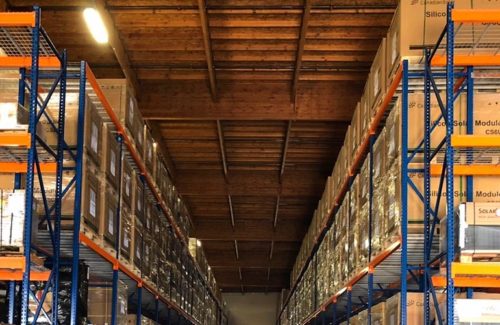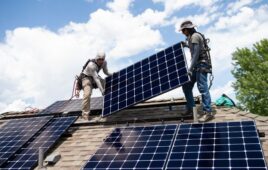By Monica Wilson Dozier and Andrew Tuggle, Bradley
Renewable energy is more popular than ever before. Regulators and ratepayers are demanding new or higher renewable portfolio standards, and investors are eager for opportunities with companies satisfying environmental, social and governance criteria. The energy transition is here, and the question is no longer if we will electrify, but how quickly.
 Significant challenges remain. As the U.S. solar PV industry continues to outperform expectations in growth and volume, many solar PV developers and contractors have transformed from entrepreneurial small business ventures into large, established and sophisticated operations. Our industry has always been global – but in 2021, it is more so than ever before.
Significant challenges remain. As the U.S. solar PV industry continues to outperform expectations in growth and volume, many solar PV developers and contractors have transformed from entrepreneurial small business ventures into large, established and sophisticated operations. Our industry has always been global – but in 2021, it is more so than ever before.
Most key components of solar PV plants in the United States are internationally sourced, and accordingly, solar procurement in particular requires complex management of cross-border risks. Due to the amount of time required to develop a solar PV plant and the routine need for early purchase of long-lead items (both to grandfather investment tax credit eligibility and to reserve space in factory manufacturing queues), solar developers and contractors often must commit to project budgets (and place purchase orders) months and sometimes years in advance of their actual spend. This requires specialized knowledge and risk management in balancing potential future market changes against the need for present certainty.
In merely the past five years, the solar procurement industry has faced last-minute extensions of the federal investment tax credits, tariffs on imported modules and steel, supply chain delays and increased costs due to the COVID-19 pandemic (and related shipping and transportation constraints), soaring prices of raw materials like aluminum and steel, significant supply constraints and various regulatory policy concerns in a volatile trade environment. In April, the Department of Energy issued a request for information to further evaluate potential replacements for the discontinued Executive Order 13920 (Securing the United States Bulk-Power System). Most recently, of course, the U.S. government has begun to raise concerns regarding the People’s Republic of China’s treatment of ethnic Uyghurs in Xinjiang, where a large portion of the industry’s polysilicon is produced. In June, the Commerce Department added five new Xinjiang-based entities to its Entity List of banned importers; in July it added 14 more. The Uyghur Forced Labor Prevention Act (UFLPA) pending in Congress has passed the Senate and may soon become law, imposing a rebuttable presumption that any products tied to Xinjiang are made with forced labor.
In this fast-growing and rapidly changing industry, in addition to considering market factors affecting price and schedule, solar developers and contractors must develop, implement and maintain robust legal compliance programs to appropriately manage the risks of engaging in international trade. At a high level, such compliance programs should focus on three areas: (1) the negotiation and execution of agreements appropriately representing both parties’ compliance with laws and regulations, including allocation of specific trade risks, (2) internal due diligence and traceability analysis of a diverse set of manufacturers, and (3) continuous monitoring of changes to import regulations and/or sanctions lists.
First, all agreements with original equipment manufacturers should clearly specify both parties’ obligations to comply with applicable laws, including laws and regulations regarding importation of equipment and the appropriate payment of sales and use-taxes for such equipment. Supply agreements should specify delivery terms (FOB/DDP), identify the importer of record, and contain appropriate force majeure and change in law provisions (including specific language addressing known or anticipated COVID-19 impacts and the pending UFLPA). Most manufacturers are already accustomed to negotiating risks relating to import tariffs or duties, including adjustments to supply agreements based on Section 201 tariffs (and the October 2020 proclamation eliminating the tariff exemption for bifacial panels). In light of the pending UFLPA, purchasers are well-advised to include specific representations and warranties from manufacturers confirming their commitment to ensure no child labor or forced labor has been used in the sourcing or manufacturing of purchased products. Best practices include making specific reference both to the relevant law and to the enforcing agency. Developers and contractors should be aware, though, that such representations only provide cover against truly unknowable risks — they do not allow purchasers to plead ignorance of knowable risks. Of course, it is also wise to consider the manufacturer’s creditworthiness, and to ensure accessible performance security (such as a parent guaranty, a letter of credit, or a surety bond) to protect the purchaser in the event of the manufacturer’s default. Particularly considering the proposed UFLPA, security for a manufacturer’s performance is best when provided by an entity outside of the borders of the People’s Republic of China.
Second, developers and contractors should implement robust internal compliance programs to understand and mitigate the risks involved in international trade. SEIA’s recent publication of its Solar Supply Chain Traceability Protocols provides a useful guideline for diligencing every tier of a supply chain. In addition and as a practical matter, purchasers should attempt to establish relationships and secure purchase orders with a varied base of original equipment manufacturers, which may allow for easier pivoting away from manufacturers who fail to comply with contractual obligations or are identified as at-risk in a traceability audit. (Of course, a diverse base of manufacturers also requires expanded supply chain diligence. Large volume purchasers may consider retaining a third party to conduct an independent traceability audit of solar supply chains, in order to allow purchasers to objectively identify and act to avoid potential issues with international manufacturers.)
The United States’ sanctions programs are administered by the Office of Foreign Assets Control (OFAC) in the Treasury Department. Current guidance from OFAC focuses on “risk-based” compliance. In a risk-based approach, there is no one-size-fits-all or check-the-box program. Instead, programs vary based on a company’s risks — size, vendor base, geographical base, products, etc. Nonetheless, OFAC looks for at least the following five components of a compliance program:
- Management commitment. “Tone from the top” is a crucial element of the success of any compliance program — OFAC or otherwise.
- Risk assessment. Risk assessment occurs during setup of a compliance program; but an initial risk assessment is insufficient. Companies must assess risk on an ongoing basis, and must continually respond to changes in vendors, operations, and even the sanctions programs themselves. Examples of risk factors include a fluctuating supply base, many high-risk vendors, and operations in high-risk geographies – all of which are common in the solar industry.
- Internal controls. Companies should implement written procedures to identify, interdict, escalate, report, and record transactions that are potentially prohibited by sanctions programs. At its core, this is the day-to-day checklist component of a compliance program. Companies sometimes overlook two risks in internal controls: First, companies should keep their sanctions lists updated with periodic re-screenings of vendors. The lists of sanctioned entities change often — a vendor that was clear yesterday may well appear on a sanctions list today. OFAC even offers hash values for its most recent lists to facilitate update searches. Second, companies should retain records of all transactions (including purchase orders, screening reports, shipping documentation, and license information) for at least five years. Adequate records are crucial for mitigating adverse agency action in the event of an accidental violation.
- Testing and auditing. A robust compliance program includes periodic internal audits to identify compliance risks and program weaknesses. Internal audits also contribute to compliance by keeping employees alert to compliance risks and their compliance functions. The scale and frequency of internal audits should be based on the extent of estimated risk.
- Training. Consistent and customized training within an organization is also critical to ensure competent implementation of a compliance program. Training should be tailored to the duties of individual personnel within the organization. As with internal testing and auditing functions, training should be scheduled based on an evaluation of potential risk.
If the implementation of a compliance program sounds onerous, developers and contractors should recognize its significant benefits in prevention and mitigation. A strong compliance program substantially assists in preventing violations – avoiding fines, expensive investigations, disclosure filings, and reputational damage. In the event of a violation, the ability to demonstrate a strong compliance program usually lessens the severity of penalties actually imposed.
Third, it is essential as the solar industry matures for procurement teams to identify new and emerging compliance risks as early as possible. Solar developers and contractors should regularly monitor official government channels for changes to regulations or updated sanctions lists. The Bureau of Industry and Security and OFAC offer email subscription options for notifications and updates (and OFAC also offers an RSS feed). The Treasury Department regularly (often multiple times per week) publishes enforcement actions, updates to sanctions lists, and new regulations and guidance on its website. Finally, it’s always useful to participate in associations monitoring legal developments and lobbying for the industry. As risk managers well know, the earlier a new risk is identified, the better, because more time allows more options for avoidance or mitigation of impacts.
As with most compliance matters, there is no silver bullet to ensure perfection (and no crystal ball to predict the future!). Global trade and its associated cross-border risks to U.S. developers and contractors will continue to pose significant challenges to the energy transition. Companies that implement appropriate policies and procedures to assess and mitigate these risks, and procurement teams who are able to identify and proactively address these risks as they continue to evolve, will be best positioned for long-term success in the solar industry. Innovation and adaptation have been key to the solar industry’s success to date, and despite the challenges ahead, there is much reason to be optimistic about the future.

 Monica Wilson Dozier is a partner at Bradley whose practice focuses on the renewable energy industry.
Monica Wilson Dozier is a partner at Bradley whose practice focuses on the renewable energy industry.
Andrew Tuggle is an associate attorney at Bradley whose practice focuses on emerging technology and international trade.






Tell Us What You Think!